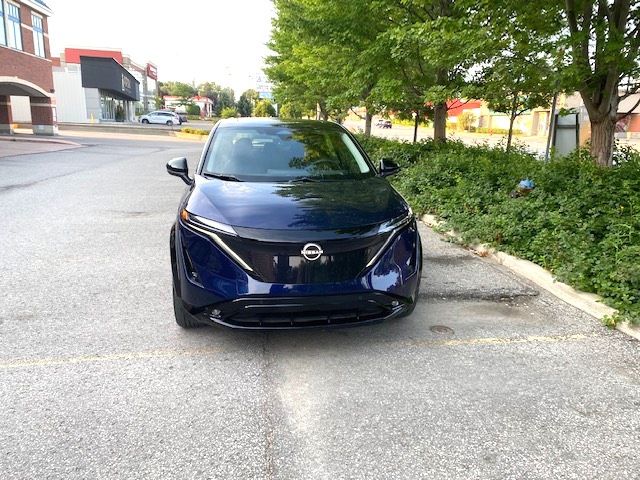
Sleek frontal styling of the Ariya. The “grille” is just a solid piece as there is no internal combustion engine to cool
History
Nissan, with their 2011 Leaf, was one of the first, commercially-successful battery electric vehicles (BEV) available. Like other manufacturers, Nissan launched their first BEV as a compact car, but like other makers, they have moved up in size and power for subsequent models, including this Ariya.
The Ariya is considerably bigger than the Leaf. Compared with the conventional Nissan Rogue crossover, the Ariya is roughly the same length, 232 mm (9.1 inches) wider, 29 mm (1.4 inches) lower and 317 kilograms (816 pounds) heavier than its conventional stablemate.
Model Mix
The Ariya was available in a bewildering array of different models in 2023 but the range has been consolidated from six to four trims for 2024. The 63 kWh and 87 kWh battery packs are still available. Front-wheel drive and dual-motor all-wheel drive can be twinned with either battery pack.
| Vehicle tested | 2023 Ariya Evolve+ front-wheel drive |
| Body style | Crossover vehicle |
| Engine | 87 kWh battery pack, 238 horsepower |
| Transmission | Single speed transmission |
| Price spread | $52,998 – $69,198 |
| Price as tested | $65,948 (including $950 for two-tone paint) |
| Estimated range | 458 kilometers with 87 kWh battery pack |
Styling
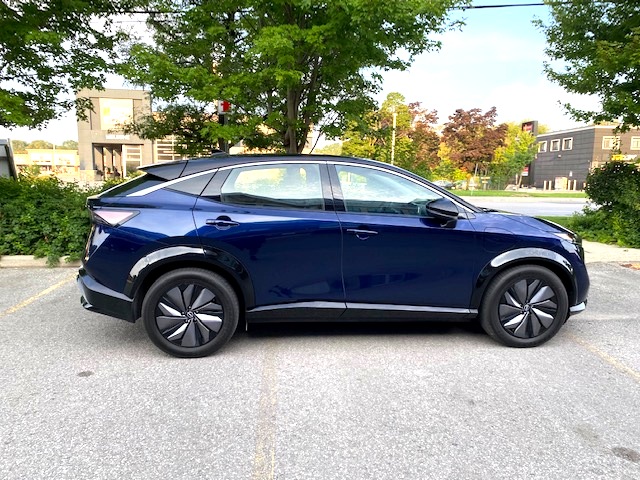
The sculptural lines of the Ariya are enhanced by tasteful bright and black accents
Styling
Starting in 2013 with their Altima and Sentra models, Nissan adopted a retro-frumpy styling philosophy that they have happily left behind. Beginning with the 2019 Altima, Nissan seem to have found their design feet again and it, and the cars that followed, the Sentra, the Rogue and the Pathfinder, have been getting more and more attractive. The Ariya continues this return to style and is certainly the best-looking Nissans in decades and a sleek, contemporary design. The front of the Ariya features very slim headlights at the leading edges of the hood, under which are chrome accent lines that parallel a large “grille” that is a solid panel as there is no internal combustion engine to cool. The Ariya’s side profile is nicely proportioned, with clean taut surfaces rather than a riot of excess ornamentation. An artful chrome accent enlivens the top of the doors. Discreet taillights are part of a full-width light bar located at the bottom edge of the rear window. Our Evolve+ trim bore glossy black wheelwell mouldings and a black roof.
Interior
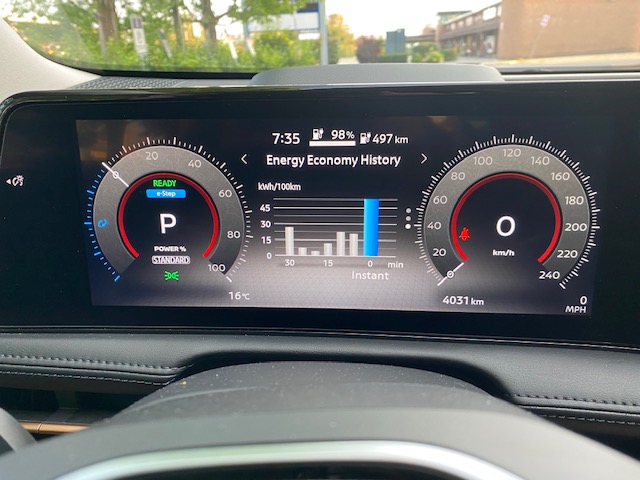
Gauge package suffers from mediocre graphics
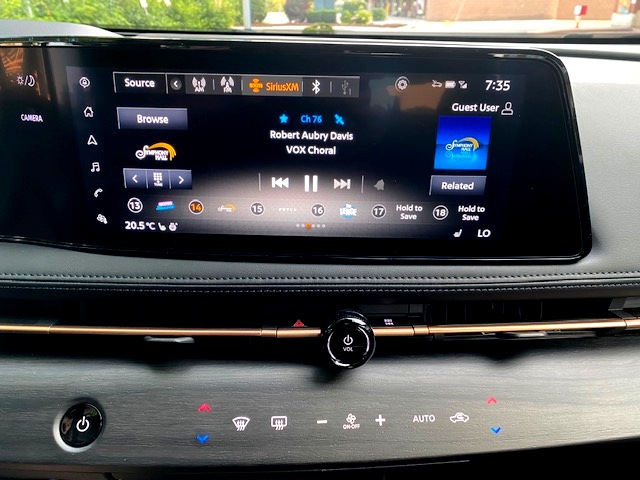
Infotainment screen graphics are lackluster. The climate is controlled by touch surfaces integrated into the faux wood dash trim
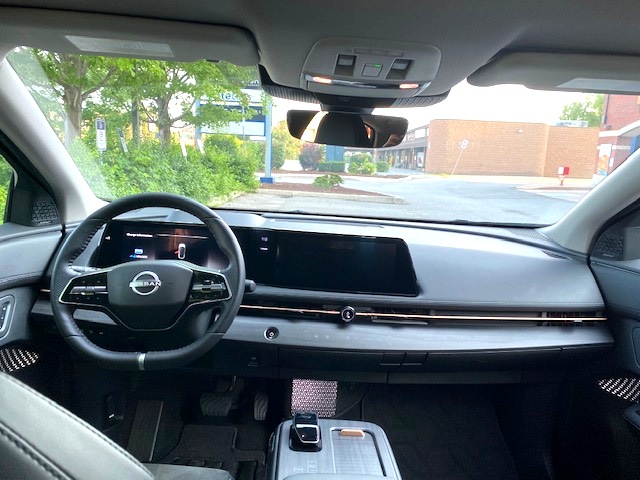
Very clean dash design of the Ariya
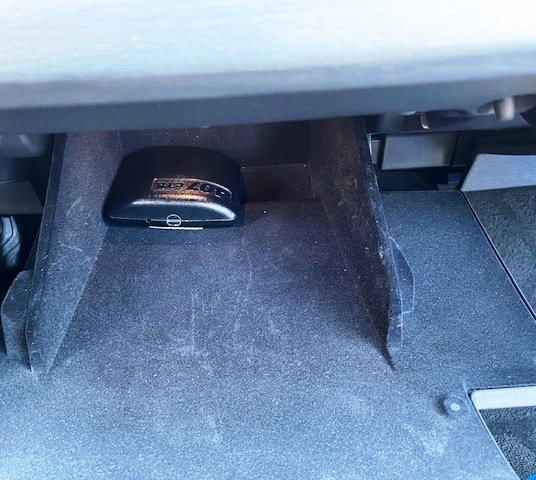
Bin that drops down from the centre of the dashboard helps compensate for the lack of storage in the centre console
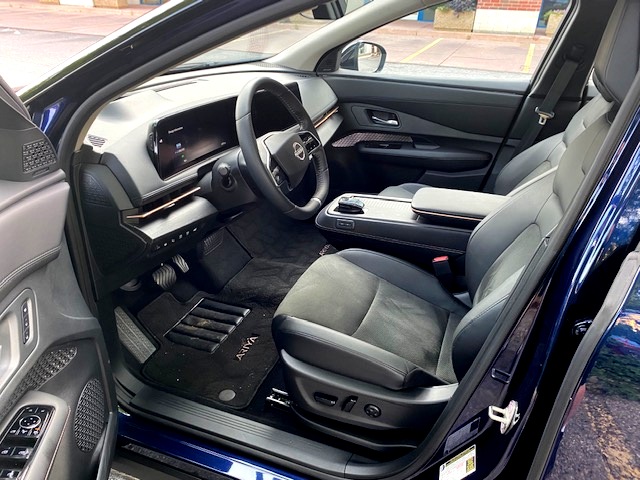
Attractive and comfortable vinyl and faux suede front seats. The flat floor imparts a feeling of space
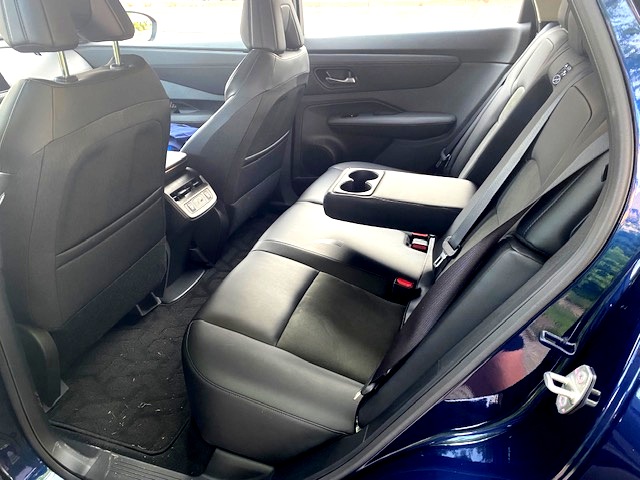
Comfortable rear seats. The lack of space for feet under the front seats reduces usable legroom for rear passengers
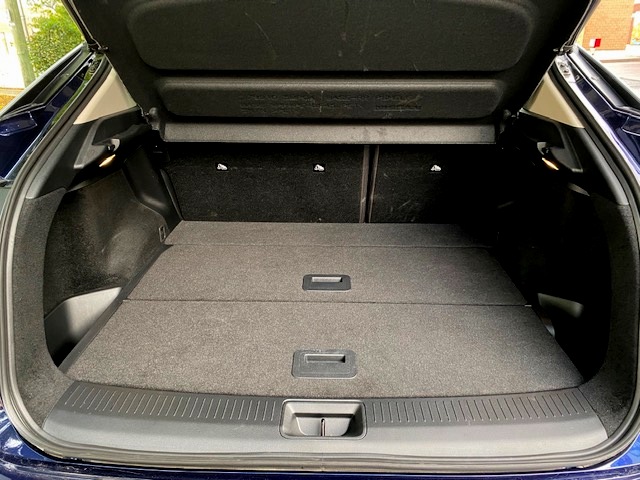
The trunk is long, not that wide and quite shallow below the window line
Like many new cars, conventional instrumentation is replaced by a shallow, rectangular computer tablet that has vehicle information displayed in front of the driver, with the right of the screen dedicated to infortainment functions. Screen graphics are unimpressive. Climate is controlled via touch surfaces incorporated into the horizontal trim that underscores the dashboard. Cabin fittings are uneven. The vinyl and faux-suede seat upholstery look very good but the gray-toned fake wood on the centre console and dashboard look down-market for such as expensive car. The “Kumiko” graphic littered throughout the cabin. The front seats are comfortable and the virtually flat floor adds to a feeling of spaciousness. However, driver’s who sit close to the wheel may find their heads contact the sun visor. The centre console between the front seats is seriously bizarre. It can be moved fore and aft electrically for some reason, and despite its bulk, it contains little useable storage. The console houses the small gear selector that moves forward for reverse, to the rear for drive and has a button contained within its housing for park. The console has touch surfaces for drive mode as well as the brake regeneration strength selector, referred to as e-Step by Nissan. In the place of console storage, the Ariya has a large bin that drops down from the centre of the dashboard. The rear seat is comfortable and legroom is ample but the low-mounted front seats preclude occupants from placing their feet under them, reducing effective legroom. The trunk is long, a bit narrow and shallow below the window line.
Performance
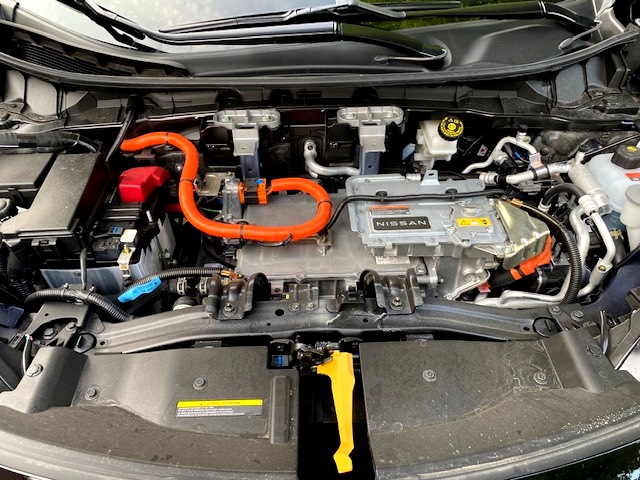
The electric motor and drive components take up as much space as a conventional gas engine would
The 87 kWh battery power of the Evolve+ trim sends 238 horsepower to the front wheels. Though power is less than is offered in competing vehicles such as the Tesla Y and Polestar 2, acceleration is strong and very smooth. Some torque-steer is evident on hard acceleration. Unlike some other BEVs, the Ariya is started and stopped with a user-friendly conventional button. Drivers can’t set and forget a level of regenerative braking but have to engage the “e-Step” mode each time the car is started, which is tedious. The regenerative braking works quite well but is not a “one-pedal” system as the driver needs to use the brake pedal to bring the car to a complete stop. Steering is nicely weighted and quick in town but lacks a “sneeze factor” on the highway and requires a steady hand to keep the car running straight. The ride is resiliently firm the majority of time but the rear suspension needs some work as it react harshly to big bumps. With a quiet motor and good control of road and wind noise, the Ariya is a very quiet car. Mediocre sound from the Bose-branded audio system. The Level 1, 115 volt charging cord that comes with the car is heavy.
Pricing
The Ariya arrives in a market with established players like Hyundai, Kia and Tesla. The Ariya is priced roughly the same as the Hyundai Ioniq 5, Kia EV6 and Tesla Y, all of which offer better range than the Ariya. The Ariya model range is structured in a way that two trims can’t really be compared. The Engage and Evolve+ trims send power to the front wheels whereas the Evolve and Platinum+ employ a dual-motor, all-wheel drive setup. Quebec offers a $7000 taxpayer subsidy for the Ariya, the federal government kicks in $5000 and B.C. residents can get a $4000 spiff from that province.
Summary
The Ariya is an attractive package, not only in looks but also as it is big enough to carry four adults in comfort but still trim enough to be an easy car to drive in the city.
Performance is strong but avoids the hyper-performance overkill that is part and parcel of BEVs like the Tesla Y or the Polestar 2.
While the Ariya is a superior effort for a Nissan, it may not be sufficiently compelling and lacks the brand cache to lure buyers away from established vehicles like the Tesla Y, Kia EV6 and Hyundai Ioniq 5.
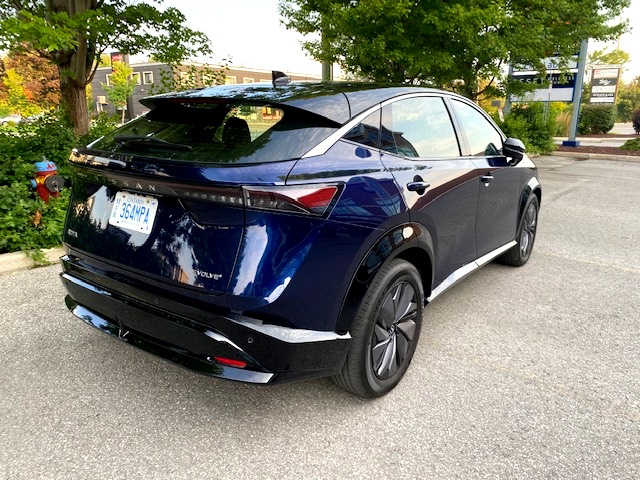
Strong, clean lines of the Nissan Ariya
